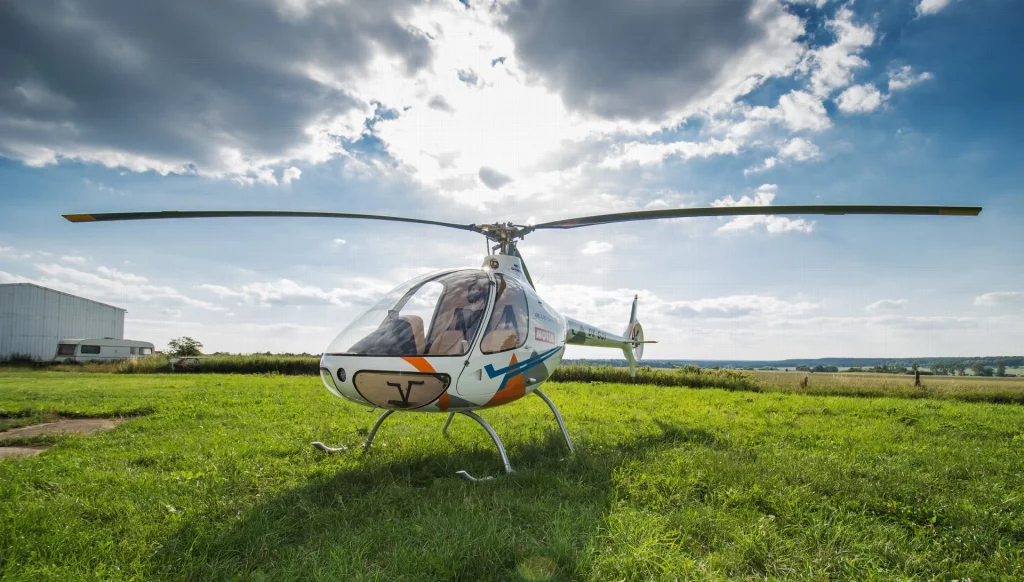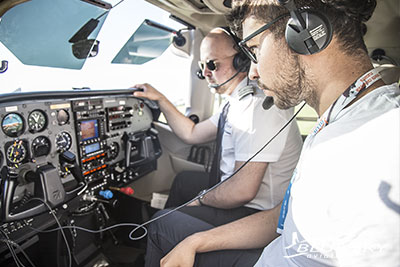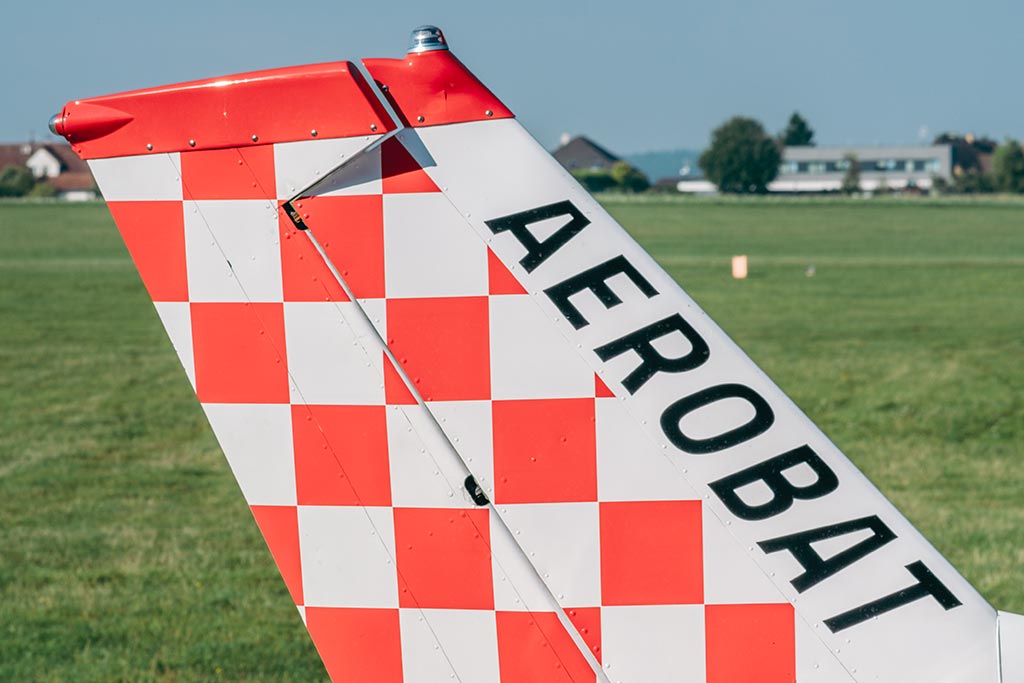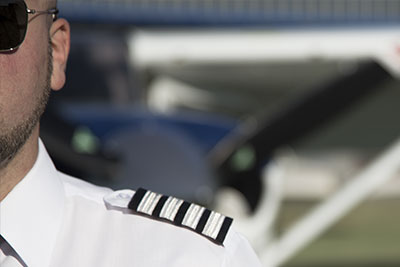We regularly receive several inquiries about pilot licenses, how to obtain them, and what an individual/student needs to acquire them. Therefore, we have decided to answer all these questions at once.
Since this is an extensive topic and the subject can sometimes seem quite complex and complicated, we would like to show you that this field also has logic and order. Hence, we will start from the very beginning and gradually progress to the licenses that allow you to sit in the cockpit of commercial aircraft.
Airplane or Helicopter?

The very start might look like deciding whether you would like to find out what piloting is, how it feels, and whether you would really like to do it. We understand this, after all, each of us was at this stage. So, if you have already thought about becoming pilots, whether in your free time or professionally, there are several paths you can take.
The very first decision one makes is quite clear and most likely already made by each of you, whether to pilot a helicopter or an airplane. One thing we want to mention at the beginning, which is also a common situation we encounter, is that society roughly knows that pilot training for commercial airplanes costs around one million Czech crowns and that amateur pilot licenses are around the lower hundreds of thousands, sometimes only tens of thousands. There is also a presumption in society that it might be similar with helicopters. Unfortunately, this is not entirely a happy assumption.

Let’s start with the fact that in airplanes, you primarily pay for the engine that rotates the propeller in front of the pilot. The propeller typically has two or three blades about 0.5 meters long. Rotating this propeller is not such a problem, and therefore airplane engines do not need to have very high power and thus high consumption. Now let’s look at a helicopter. What the wings largely manage in an airplane, and for which there is no need to pay, a helicopter manages with a so-called rotor. Just imagine a helicopter and you know that this rotor must be spun by “some” engine. Yes, the rotor of a helicopter is really significantly larger. And therefore, the opposite logic applies. The engine of a helicopter must have high power and consequently higher consumption. Thus, when we talk about a pilot license for a helicopter, compared to airplanes, we are talking about a significantly higher price.
If an airplane that fits two people costs around 2,000 to 4,000 Czech crowns per hour, a helicopter that also fits two people will cost from 9,000 Czech crowns per hour and more. Therefore, obtaining a pilot license for helicopters is two to three times more expensive than obtaining a similar pilot license for airplanes.
Thus, if we need one million Czech crowns to obtain a commercial airplane pilot license, two to three million Czech crowns are needed to obtain a commercial helicopter pilot license. It sounds like a desperate situation, especially if you don’t have millions in your account, but there is a solution.
If you really wish to be a professional helicopter pilot, there is an almost free option to become one through the military. Of course, the demands on health are higher and not everyone is selected, but it is still a way to get into the cockpit of a helicopter. And we will please you with the fact that the Czech Army is facing an overall shortage of helicopter pilots. Therefore, everyone who can and meets the requirements is certainly welcome.
Which Pilot License to Choose?
Let’s start with the pilot license for flying an airplane. In the very first phase, it is important to know whether a person is aiming to be a commercial airplane pilot or at least to a license that allows them to earn money by flying. A basic pilot license is not enough for a person to fly commercially, i.e., for a fee. Even if you have a pilot license for an airplane with which commercial flying is possible, it still doesn’t mean that you can earn money by flying.
If a person does not have ambitions to be a commercial pilot and wants to spend their free time flying, rent an airplane, and fly only for their personal needs or take a trip with friends and share the costs, then there are several paths they can take.
Pilot License – Glider Pilot
This is purely a matter of the heart. Training for a motorless glider can start already at the age of 15. Most of the training to obtain a pilot license – Glider pilot takes place in local aeroclubs, mainly during spring and summer. This flying can even be considered professional at a higher flight time, and a person can participate in various competitions.
If you are considering a glider pilot license, the simplest way is to find the nearest airport in your area. There, look for the local aeroclub and ask about the possibilities of training for a glider. Initially, of course, you will face theory, but soon you will dive into the aircraft. The advantage of this pilot license over others is that you can complete the training at a young age, and the cost is the lowest among all training.
The Civil Aviation Authority will issue you a pilot license for a glider. Only in the case that you decide to fly a glider that falls into the ultra-light (UL) category, the training will be conducted under the Light Aircraft Association, which will then also issue you the corresponding pilot license for Ultra-light Gliders.
Pilot License – Ultralight Aircraft Pilot
Or ULL is a license for single-engine aircraft that have their takeoff weight under 600kg. This is again purely a matter of private flying. Two people can fit into an ultralight, and the cruising speed of the aircraft ranges between 100 to 300 km/h. The training for this type of flying is in the range of 20 hours, but that is just the minimum requirement. Most students manage this training in 30 to 35 hours.
The use of the pilot license for Ultralight Aircraft Pilots is primarily for private needs. ULL aircraft pilots can rent a ULL aircraft and take a flight, or they can use the aircraft as an occasional means of transportation. Recently, it is common for a pilot to buy their own ULL aircraft after completing the training and then use it for their private needs. With such an aircraft, you can travel around Europe or fly to business meetings in the Czech Republic. However, the ULL pilot license does not entitle you to operate for profit. All flights can be at most for shared costs. Prices for such aircraft start at 500,000 CZK. So, currently, instead of a new car, you can buy an Ultralight Aircraft.

The training to obtain the Ultralight Aircraft Pilot license is conducted under the Light Aircraft Association (LAA), which will then also issue you the corresponding pilot license for Ultralight Aircraft Pilots. The training itself is provided by a flight school with the appropriate authorization from LAA, for example, our flight school BLUE SKY AVIATION.
Pilot License – Private Pilot License (PPL(A) – Private Pilot License)
Training for the Private Pilot License (PPL(A)) is conducted on aircraft without a weight limit and thus on aircraft of general aviation (General Aviation). Regarding legislation, this pilot license is conducted under the Civil Aviation Authority according to the syllabus established by EASA (European Aviation Safety Agency) and is thus recognized in the surrounding European states.
The training is in the range of 45 flight hours with an instructor and supplemented by a PPL(A) theory course. Since this training is already under the EASA syllabus, it is also the first step in the training of a commercial pilot. However, this does not mean that once you obtain a PPL license, you must then continue training to become a commercial pilot. Often, pilots without these ambitions obtain a PPL license with us. They just want to take advantage of this pilot license, which is the possibility of flying on larger aircraft into which more than 2 people can fit. These larger aircraft are also often certified for flights in more demanding conditions and for night flights. The Private Pilot License can be expanded with additional courses for instrument flying and night flying to a certain extent, getting rid of the limitations regarding weather and time of day.

A pilot with a PPL license can thus sit in an aircraft that has one piston engine and can have up to 6 people on board if the aircraft allows it. Further training for the PPL license may allow the pilot to sit in a single-engine aircraft with a turbine. Thus, greater power, longer range, and it can transport more people and cargo. Or the pilot can expand their license to fly a twin-engine aircraft, where the main advantage is greater safety, which you will appreciate, especially on longer flights.
The PPL license thus has its advantages. The disadvantage might be the price. While the ULL pilot license can be managed within tens of thousands of Czech crowns, for the PPL license, it is already hundreds of thousands of Czech crowns, and if we were to continue to turbine aircraft, we would get to millions.
The Path to the Commercial Pilot License
Now that we have defined the basic pilot licenses, we can move on to the training of a professional pilot. This can be divided into three possible paths.
- Modular training
- Integrated training
- MPL or multi-crew pilot license
The result of all three paths is a pilot with a commercial license, who is capable of flying for an airline or a training organization and earning money by flying. However, the paths to it are different.
Pilot License – MPL – Multi-Crew Pilot License
The Multi-Crew Pilot License (MPL) is relatively new and increasingly used nowadays. The training to obtain this pilot license consists of an accelerated pilot training syllabus. The training syllabus may vary depending on the organization providing the training. The primary purpose of MPL training is to shift as many hours as possible from a real aircraft to a simulator. Thus, up to 75% of the entire flight training in MPL training can be flown on a simulator. The structure and content of the training that the pilot goes through are quite different from the other two possible paths. Essentially, the student spends most of the time on a commercial aircraft simulator with the goal of then flying this specific aircraft as a commercial pilot.
MPL training is most often used in so-called cadet programs. Cadet programs are organized by airlines with the aim of training their own pilots. In practice, it looks like a large selection process is organized for applicants who want to be pilots but have no pilot licenses or other aviation experience. Applicants who succeed in the selection process receive a job guarantee immediately after completing MPL training. This training is relatively brisk and intensive. It is always conducted under some airline (airline) and it is not common for a student to do MPL training on their own and then look for a job.
Modular Training
This is the most frequently chosen path to a professional pilot in the Czech Republic. It has a number of advantages and a number of specifications that are important to consider.
Modular training consists of modules that the student gradually completes. At the end of each module, the student is given competence in the form of an official document from the Civil Aviation Authority. Each of these competencies expands his piloting possibilities both skill-wise and legally. The modules are interconnected and with an appropriate gradient, the student gradually gets to the license of a commercial pilot.
Within this training, the student completes approximately 200 hours in an aircraft and thus goes through a number of modules as already mentioned. These modules are nothing more than training focused on a certain type of flying. It’s essentially like when you would get a motorcycle driving license at 16 years old, a car driving license at 18, and then continued through all types of driving training to a tram. And that’s basically what it looks like in aviation.
PPL – Private Pilot License
As already mentioned, the private pilot license (PPL(A)) is the license with which a candidate for a commercial pilot career starts. It’s not that you have to start with this pilot license right at the beginning, often people first jump into the ULL license or glider, but this is the first pilot license and type of flying that is officially recognized and counts towards professional training for a commercial/airline pilot. More about the private pilot license above.

Training for the PPL can start at the age of 16. Yes, before sitting in a car, you will be able to pilot an aircraft! However, the regulation then limits the progress of training. The student must be 17 years old to complete the training and obtain the PPL(A) pilot license. The training is then concluded with an examination with an examiner. Just like in driving school, you must prove that you have the necessary skills for safe control of the aircraft and solving crisis situations that may occur during flight.
The PPL license entitles you to pilot a single-engine piston aircraft (so-called SEP – Single Engine Piston). This pilot license is valid for flights that are carried out in good meteorological conditions. Simply put, the pilot flies during the day, outside of clouds, and has good visibility around and especially in front of him and to the ground. And that brings us to the next part of modular training.
Night Training
The next step is nothing more than transferring your abilities to fly in good weather with a single-engine piston aircraft during the day to flying under the same conditions also at night. This training is in the range of 5 hours and is not concluded with an examination. Only an entry into the PPL license that the pilot can operate the aircraft at night.

Airline Transport Pilot Theory
After completing the private pilot training and obtaining the PPL pilot license, students sign up for the airline transport pilot theory – ATPL Theory (Airline Transport Pilot License). This is a theoretical course concluded with exams from 13 subjects at the Civil Aviation Authority. The course usually lasts about a year. This theory then suffices and is also one of the requirements for all subsequent flight training up to obtaining the pilot license for a commercial pilot.

Time Building

As part of the entire modular training, the student must fly at least 100 hours as the commanding pilot. This means you will spend a lot of time in the aircraft on various trips and sightseeing for acquaintances and family. The reason is the following. Advanced training requires already having the aircraft in hand, which is achieved through flight time and experience. These experiences are then required for the start of advanced training. And they are the following.
IR – Instrument Rating
Instrument rating (IR) or instrument qualification in Czech is not a pilot license in itself. It is a pilot authorization that is entered into an already obtained pilot license, whether it is a private pilot license PPL or a commercial pilot license CPL; we will talk about it later. To start IR training, you must have flown at least 50 hours as the commanding pilot. Students most often complete this training right after completing ATPL theory.
This training teaches the student to fly without visibility of the ground using all navigation systems in the aircraft. Thanks to this, the pilot learns to fly even in adverse weather. The procedures learned in this training are already used in commercial flying, thus this training is key. The syllabus has 40 to 50 hours and is largely filled on a simulator, to simulate various non-standard situations that cannot be simulated in an aircraft normally or would be dangerous. The flight part of the training is then filled on a single-engine piston aircraft, which is of course certified for instrument conditions. Not all aircraft are.

MEP – Multi Engine Piston Aircraft Rating

Multi-engine piston (MEP) or training for flights on multi-engine piston aircraft is another step in professional training, where the primary goal is for the student to learn to control an aircraft that has more than one engine. The reason for this is that in case one engine fails, instead of an immediate emergency landing, as is the case with a single-engine aircraft, the procedure for shutting down the dead engine and landing procedure at the airport with one functioning engine is practiced. It seems like a trivial matter, but for a pilot, it is quite a new thing.
In a single-engine aircraft, you can never experience the situation of so-called asymmetric thrust. This means that one side of the aircraft pulls and the other side brakes. Which of course pulls the aircraft into a spiral and the pilot has to fight against it. The training in this case is designed so that the pilot learns to handle these things both in good and bad weather. The syllabus has 11 hours and is divided into a part of flights in good visibility and instrument time. And again, you can go into training only when you have 70 hours as the commanding pilot. Thus, it is most often the choice for students after IR training.
CPL – Commercial Pilot License
The Commercial Pilot License (CPL(A)) finally allows you to fly for profit! It is a pilot license that gets you among pilots who actually make a living by flying. The training syllabus is nothing but a repetition of already learned things, but with one difference, and that is that the precision and accuracy required of the pilot is much greater than in previous training. Within the CPL syllabus, you will complete 15 hours in the aircraft. This training can be started by the pilot only after reaching the aforementioned 100 hours in the position of the commanding pilot of the aircraft. Therefore, this training is most often ranked at the end of the entire training.
After completing this training, which is, as in previous cases, concluded with an examination with an examiner, the Civil Aviation Authority will issue you a new pilot license/pilot certificate – commercial airplane pilot CPL(A) and all the pilot qualifications you have obtained so far from your previous private pilot license PPL(A) will be transferred there.

A-UPRT – Advanced Upset Prevention and Recovery Training

Advanced UPRT training is only an additional and relatively newly introduced training for future airline pilots with a rather complicated name. It is essentially a three-hour quick training, where the student is supposed to experience any non-standard positions the aircraft can get into plus light acrobatic elements. This clause, which is not even concluded with an examination, is then required by airlines in selection processes.
MCC – Multi-crew cooperation
With this, the Modular training ends, and the pilot can go look for a job.

Integrated Training
As for the mentioned three paths to a career as an airline pilot, the path of MPL training is quite distinct and the entire concept of MPL training is very specific. In contrast, the path of modular and integrated training, from the perspective of an external observer, may seem the same. The syllabi are almost identical, the hours and lessons are almost identical. The number of flown hours is almost the same. Yet, there is a huge difference in these trainings!
Integrated training – as the name suggests, is taken as one big training concluded with one big official examination. Now imagine taking all parts of modular training together and making one syllabus out of them. Yes, exactly that’s what it looks like. Of course, thanks to integrating all trainings, you will fly a bit fewer hours in the end in integrated training, but it has one disadvantage compared to modular training. And that is that the official pilot license – commercial pilot airplane license CPL(A) is obtained only after completing the entire training. Whereas in modular training, after 45 hours and an examination, you obtain the PPL pilot license, you are officially a private pilot and can fly the aircraft according to your own intentions. Integrated training has its time limit, so it may happen that you are quite rushed to finish; otherwise, the training expires, and you have to do it again. This is not the case with modular training.
An advantage could also be mentioned in the form of the possibility of choosing training organizations for your modular training. Simply do your research and it turns out that each module is better done somewhere else, and you go and get each license from a different training organization. In integrated training, you sign up to one school at the beginning, and you also have to finish it there.
Integrated training is most often associated with large training organizations and often also with programs for pilots at universities. There are flight schools that can guarantee you the possibility of selection procedures at airlines, or guarantee you a job, thanks to completing integrated pilot training. But it’s not always reliable. I myself, as an instructor, taught students who were doing training directly for airlines as part of integrated training, but due to the crisis in aviation in 2020 and 2021, the airline withdrew from the contract, and the students then had to look for a job on their own.
It’s good to note that the license issued at the end of both integrated and modular training is absolutely identical, and the law does not distinguish them.
Read more about the course of training and the advantages and disadvantages of modular and integrated training in our article How to Become an Airline Pilot.













